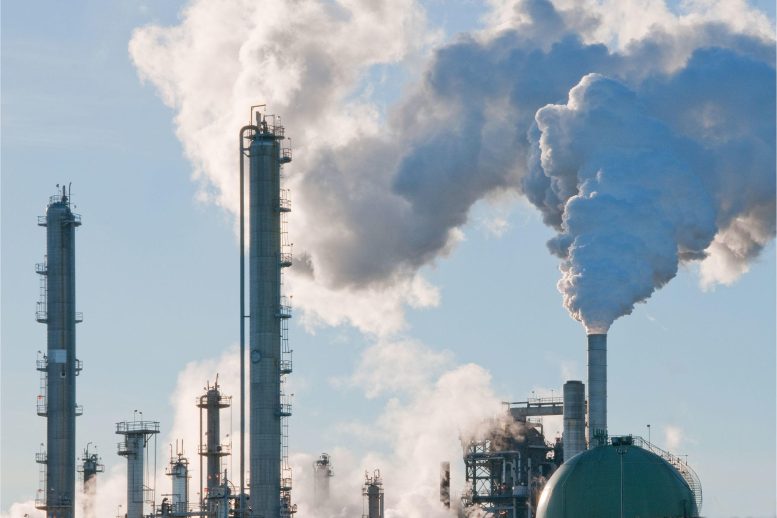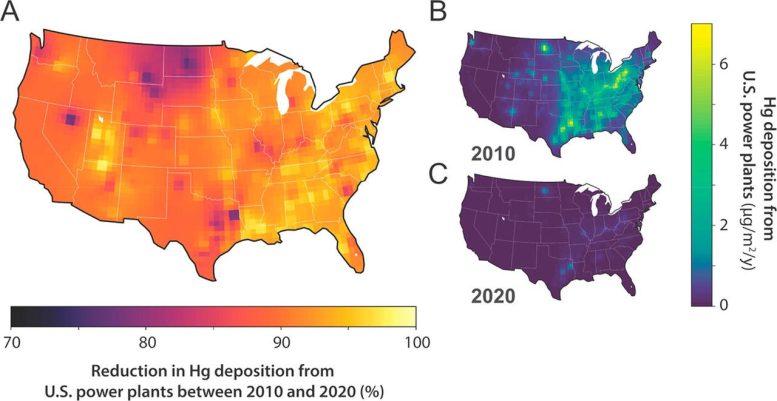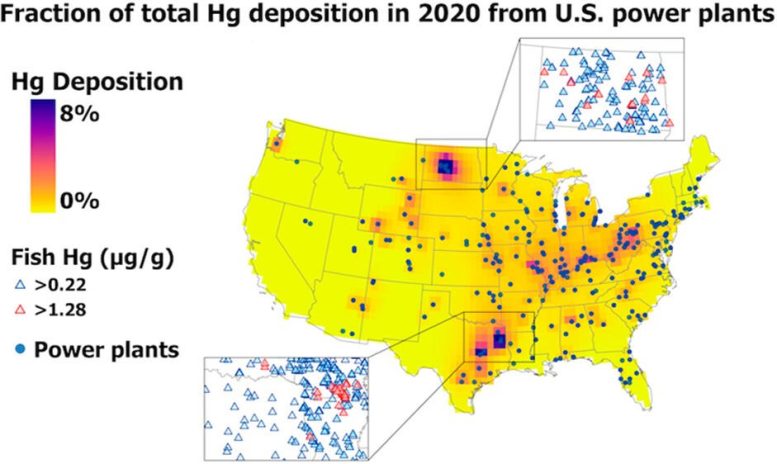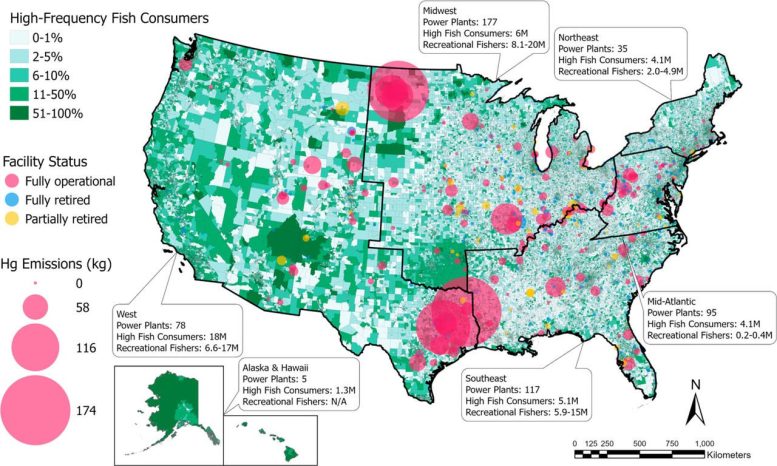
A new study reveals that in the decade since the implementation of the Mercury and Air Toxics Standards (MATS) by the U.S. Environmental Protection Agency, mercury emissions from U.S. power plants have decreased by 90%. Despite this significant progress, Texas and North Dakota, which burn lower-quality lignite coal, remain high emitters of mercury, with the research also highlighting sociodemographic disparities where poorer, less educated, and limited-English communities are disproportionately exposed to dangerous mercury levels.
New research reveals a notable socioeconomic gap in who breathes the most toxic air.
Partisan political debates often neglect to highlight the impressive results yielded by the federal government’s signature environmental laws. A case in point is the Mercury and Air Toxics Standards (MATS) established by the U.S. Environmental Protection Agency. These rules were designed to mitigate the detrimental effects of hazardous air pollutant (HAP) emissions originating from fossil fuel-burning power plants.
A recent research paper published by the Harvard John A. Paulson School of Engineering and Applied Sciences (SEAS) reveals a significant reduction in mercury emissions over the past decade, thanks to these standards. Mercury emissions from U.S. power plants have plummeted by 90%, meaning less of the neurotoxic substance ends up in the atmosphere, soil, water, and ultimately the food chain. Mercury is a potent neurotoxicant and has been linked to higher risks of fatal heart attacks among adults.

Mercury from coal-fired power plants has decreased by 90 percent since the 2011 MATS rules went into effect. Credit: Harvard SEAS
The new paper analyzes sociodemographic disparities in mercury exposures from U.S. power plants and residual risks remaining for the most highly exposed populations. The research is published in the journal Environmental Science & Technology Letters.
Before MATS was promulgated in 2011, coal-fired power plants were the largest domestic source of dangerous mercury emissions. In 2005, coal-fired power plants accounted for 50 percent of all primary U.S. mercury emissions sources. The MATS regulation forced all power plant operators to meet the top tier of emissions control performance standards across the country. Many operators chose to shut down coal-fired electricity generating units when the price of natural gas fell. Some switched fuel types altogether to burn natural gas, a fuel source that produces negligible mercury emissions. Of the 507 coal-fired power plants that were operating in 2010 before the MATS rules went into effect, 230 were fully retired and 62 were partially retired by 2020.
“The MATS regulation is another wonderful success story linked to the Clean Air Act Amendments of 1990,” said Elsie Sunderland, Fred Kavli Professor of Environmental Chemistry and Professor of Earth and Planetary Sciences at SEAS. “This regulation has effectively eliminated most of the last remaining U.S. mercury emissions point sources, with benefits for millions of freshwater and recreational anglers across the country.”

Texas and North Dakota remain hotspots for mercury in emissions from power plants. Credit: Harvard SEAS
Despite the historic national progress, two regions stand out as stubborn continuing sources of mercury emissions: Texas and North Dakota. Both states are home to power plants that burn locally mined lignite coal, which is a lower quality and less dense energy source compared to the bituminous coal that fuels plants in most other parts of the country. This means that lignite burning control standards for mercury in 2012 were less stringent than those developed for most U.S. power plants and mercury emissions remained higher than in other areas after the MATS rule was implemented.
The EPA is required to periodically evaluate whether advances in available technology merit updates to its standards. The agency has now proposed changes to MATS that would compel operators of lignite coal-burning power plants to adopt technologies that would significantly reduce their toxic emissions. These proposed more stringent standards are open for public comment until June 23, 2023.

People who eat fish from areas near coal-fired power plants are at greatest risk of the health effects of mercury. Credit: Harvard SEAS
“Our recent work suggests that strengthening the MATS rule, as proposed by the Biden Administration, would eliminate the last two remaining mercury deposition hotspots in the United States attributable to coal-fired power plants. This is an important change that will benefit vulnerable communities and indigenous groups,” said Sunderland.
The Harvard team also investigated whether the socio-demographic characteristics of people living near power plants that continued to operate in 2020 differed from those living near facilities that had retired since 2010. They found that those who continue to be exposed to dangerous mercury levels from power plant emissions tend to be poor, less educated, and from limited-English households.
“This work reinforces the lack of distributional justice in the siting of U.S pollution sources and exposures, with effects on the health of the most vulnerable individuals and communities,” said first author of the new paper Mona Dai, a Ph.D. student in Sunderland’s Lab.
Reference: “Sociodemographic Disparities in Mercury Exposure from United States Coal-Fired Power Plants” by Mona Q. Dai, Benjamin M. Geyman, Xindi C. Hu, Colin P. Thackray and Elsie M. Sunderland, 5 June 2023, Environmental Science & Technology Letters.
DOI: 10.1021/acs.estlett.3c00216
Additional authors include Benjamin Geyman and Colin Thackray from SEAS and Xindi Hu from Mathematica, Inc.
Financial support for this work was provided by the Energy Foundation and the Harvard NIEHS Superfund Research Center.









“People who eat fish from areas near coal-fired power plants are at greatest risk of the health effects of mercury.”
Interestingly, just what the risk is wasn’t quantified. It is asserted that lignite burning produces more mercury than bituminous coal, but nothing is said about the relative emission per kilowatt-hour. It is also assumed, apparently, that all fish are equally likely to have equal concentrations of Hg regardless of the species or environment in which they live.
Last I checked, the determination of methylmercury in fish was done on raw fish, when done at all. Methylmercury is volatile, having a boiling point the same as water. Cooking, particularly pan frying, will reduce the concentration of methylmercury, which will be vented if there is a range hood, which most modern homes have. Perhaps that is why there isn’t a single well-documented case of methylmercury poisoning from consuming fish in the USA. The researchers haven’t made the case that fish near the ‘hot spots’ are unsuitable for eating.
Another example of research ‘good enough for government work,’ but leaves a lot of unanswered questions with unstated assumptions.